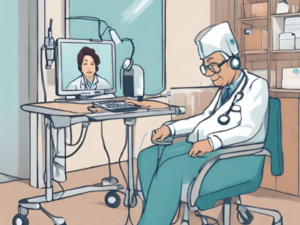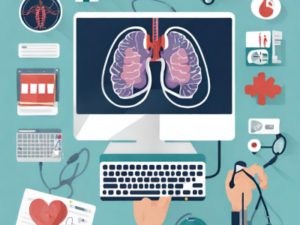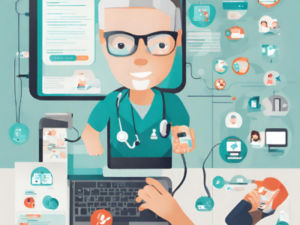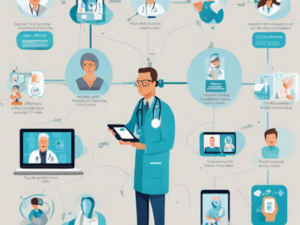Module 3: Patient assessment situation through telecare
- Description
- Curriculum
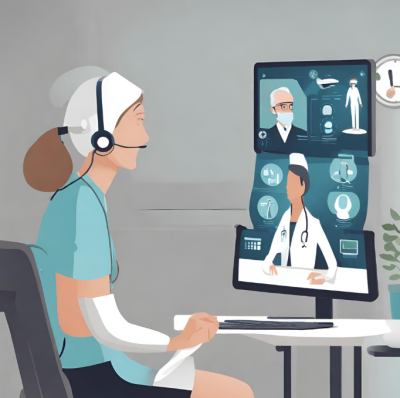
-
2Lesson 3.1 Basic Principles for Effective Assessment of Patients via Telecare
Introduction
Nurses, physicians, and advanced practice clinicians who practice telecare must consider the components required to complete an effective patient-assisted remote assessment and plan ahead based on their specialty area and the patient’s presenting complaint.
The most significant difference between telehealth visits and in-person visits is the health professionals’ inability to perform a hands-on assessment. Nevertheless, the standard of care remains the same whether the visit is in person or remote.
Accurate patient assessments, conducted via telehealth or in-person, are key to preventing diagnostic errors. To learn more about the relationship between patient assessments and diagnostic error, The Doctors Company studied 428 primary care malpractice claims that closed between 2015 and 2020. Analysts found that 74 percent of the diagnostic error claims involved patient assessment failures. The top three factors contributing to these assessment gaps and, ultimately, to diagnostic error were failure or delay in ordering a diagnostic test (38.8 percent), failure to assess and address continued symptoms (32 percent), and failure to establish a differential diagnosis (23.8 percent).
Nurses must ensure that information gleaned during a remote assessment is sufficient to determine the patient’s nursing diagnosis and treatment. Patient selection and preparation are also essential to the safety and success of the visit.
General aim
The aim of Lesson 3.1 is to provide specialized knowledge about the principles that are fundamental for the effective assessment of the patients through telecare.
Objective
To provide the main principles and strategies that nurses need to know and to apply in order to effectively assess patients’ health status through telecare.
Learning Outcomes
Knowledge
§ Identify and describe the most common and emerging principles for health assessment through telecare.
§ Identify and describe specific and context-related methods that are fundamental for virtual health assessment.
§ Be critically aware of and describe how to use ICTs in order to access patients' healthcare records and thus track the data and monitor the health status of a patient.
Skills
§ Enact specialized skills to integrate in daily practice the most common and principles for health assessment through telecare.
§ Enact specialized skills to integrate in daily practice specific and context-related methods that are fundamental for virtual health assessment.
§ Assess the suitability and effectiveness of methods, tools and services for health assessment through telecare.
§ Provide guidance on the integration of virtual health assessment.
Competences
§ Have a positive attitude towards methods and technologies in health assessment via telehealth.
§ Autonomously integrate virtual assessment in daily practice of telenursing.
§ Disseminate the role of effective assessment in health promotion via telecare.
§ Show an aptitude for continuous learning about virtual assessment.
-
3Lesson 3.2 Fundamentals of Nursing Assessment
Introduction
Assessment is the first step in the nursing process and includes systematic collection, verification, organization, interpretation, and documentation of data for use by health care professionals. Effective planning of patient care depends on a complete database and accurate interpretation of information. Incomplete or inadequate assessment may result in inaccurate conclusions and incorrect telenursing interventions. Proper collection of assessment data guides the decision-making activities of professional nurses. Assessment is the collection and analysis of data that are used in formulating nursing diagnoses, identifying outcomes and planning care, and developing telenursing interventions.
General aim
The aim of Lesson 3.2 is to provide specialized knowledge about nursing assessment, types of assessment, and the use of data in the effective assessment process.
Objective
To provide the main nursing assessment models and methods, types of assessment, and knowledge about how to gather information by using the nursing health history.
Learning Outcomes
Knowledge
§ Recall basic methods of health data collection.
§ Describe the types of assessment.
§ Differentiate subjective and objective data.
§ Describe all methods involved in data collection.
§ Explain the stages of the assessment interview.
§ Outline the elements of the health history and their importance.
§ Discuss the use of data clustering in organizing the information obtained about the patient.
§ Identify the types of assessment formats.
§ Identify the proper standardized and validated assessment tools for individuals’ health status and health needs.
Skills
§ Evaluate all the dimensions (biological, mental, spiritual, social) of individuals’ health status.
§ Perform a specialized assessment on health status with the use of standardized and validated evaluation tools.
§ Assess individuals’ health needs within a specific context, even in complex situations.
§ Detect frequent health problems of individuals within a specific context.
§ Collect individuals’ data through observation, interview and virtual examination.
§ Compose a nursing report of the identified level of individuals’ health status, health needs and health risks.
Competences
§ Perform a highly specialized analysis of health status and health needs of individuals within a specific context.
§ Take responsibility on cooperation with individuals in order to detect health problems and assess health needs.
§ Apply critical thinking to the identification of individuals’ health problems.
§ Demonstrate an intra and interdisciplinary team approach to detect health problems of individuals within the context of their cultures.
§ Compose the nursing report autonomously.
-
4Lesson 3.3 Guidelines for a Patient – Assisted Virtual Physical Examination
Introduction
A telemetry nurse uses different devices and technology to monitor patient blood pressure and oxygen saturation, heart rhythms and respirations, and other data. Then they record the information and interpret the data to help the doctor assess how the patient is recovering and allow the physician to determine a treatment protocol. Since they are registered nurses, they also do patient care and offer pre-dismissal education about a patient’s condition. These nurses are in demand, because there is a shortage of critical care beds. That means that hospitals must step up or step down patient classification. This process, called “Progressive Telemetry Nursing” includes patients who are still critical or whose conditions may easily worsen to critical, but who are more are less stable. Nurses must be critical thinkers who can make rapid decisions. Another facet to telemetry goes beyond the bedside vigilance over acute care patients to those who are mobile and who wear transmitters that send vital signs to a deceiving station, allowing those patients to move around and yet be constantly monitored.
The aim of Lesson 3.3 is to provide specialized knowledge about the patient-assisted virtual physical examination.
Objective
To provide the main principles and strategies that nurses need to know and to apply in order to effectively conduct a patient-assisted virtual physical examination.
Learning Outcomes
Knowledge
§ Identify and describe the most common devices that nurses use to conduct a patient – assisted virtual examination.
§ Identify and describe specific and context-related methods that are fundamental for virtual physical examination.
Skills
§ Enact specialized skills to integrate in daily practice the most common principles for a patient – assisted virtual examination.
§ Enact specialized skills to integrate in daily practice specific and context-related methods that are fundamental for a patient – assisted virtual examination.
§ Assess the suitability and effectiveness of methods, tools and services for a patient – assisted virtual examination.
§ Provide guidance on the integration of a patient – assisted virtual examination.
Competences
§ Have a positive attitude towards methods and technologies of a patient – assisted virtual examination.
§ Autonomously integrate a patient – assisted virtual examination in daily practice of telenursing.
§ Disseminate the role of effective assessment in health promotion via telecare.
§ Show an aptitude for continuous learning about a patient – assisted virtual examination.
-
5Lesson 3.4 Remote Monitoring of Patient’s Vital Signs
Introduction
Remote monitoring is an innovative strategy to promote health and improve patient management and care. Disease-related and physiological data on the patient are digitally transmitted via telephone, internet, or videoconferencing, from the patient’s home to a health care center, providing clinical feedback. It allows early detection of disease decompensation—enabling early interventions and a reduction of mortality and hospitalizations—and patient education, improving their self-management. Technology has undergone many transformations, allowing the widespread use of telemedicine. Nowadays, devices such as intelligent sensors, wearable or hand-held devices, Internet-connected cell phones, and implanted monitoring devices are widely available. The large number of publications on telemonitoring over the past ten years shows the increasing importance of technology in health care. Remote patient monitoring improves outcomes by allowing regular remote monitoring of vital signs to fight chronic disease and better access for all to healthcare via an everyday smartphone or tablet:
- Long-term condition (LTC) management
- Remote pre-op assessment, eliminating wasted journeys for patients and clinical time
- Early discharge monitoring
Remote patient monitoring or telemonitoring aims at improving patient care through digitally transmitted health-related data. That allows early detection of disease decompensation and intervention, patient education and improves patient–physician relationship.
General aim
The aim of Lesson 3.4 is to provide specialized knowledge about the remote monitoring of the patient’s vital signs.
Objective
To provide the main principles and strategies that nurses need to know and to apply in order to effectively conduct a remote monitoring of the patient’s vital signs.
Learning Outcomes
Knowledge
§ Identify and describe the most common devices that nurses use to conduct a remote monitoring of the patient’s vital signs.
§ Identify and describe specific and context-related methods that are fundamental for remote monitoring of the patient’s vital signs.
Skills
§ Enact specialized skills to integrate in daily practice the most common principles for a remote monitoring of the patient’s vital signs.
§ Enact specialized skills to integrate in daily practice specific and context-related methods that are fundamental for a remote monitoring of the patient’s vital signs.
§ Assess the suitability and effectiveness of methods, tools, devices and services for a remote monitoring of the patient’s vital signs.
§ Provide guidance on the integration of a remote monitoring of the patient’s vital signs.
Competences
§ Have a positive attitude towards methods and technologies of a remote monitoring of the patient’s vital signs.
§ Autonomously integrate a remote monitoring of the patient’s vital signs in daily practice of telenursing.
§ Disseminate the role of an effective remote monitoring of the patient’s vital signs. in health promotion via telecare.
§ Show an aptitude for continuous learning about a remote monitoring of the patient’s vital signs.

